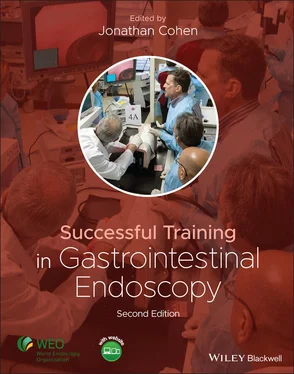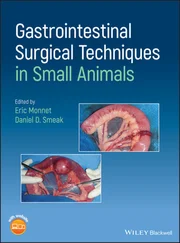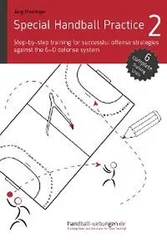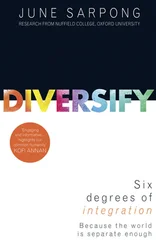Successful Training in Gastrointestinal Endoscopy
Здесь есть возможность читать онлайн «Successful Training in Gastrointestinal Endoscopy» — ознакомительный отрывок электронной книги совершенно бесплатно, а после прочтения отрывка купить полную версию. В некоторых случаях можно слушать аудио, скачать через торрент в формате fb2 и присутствует краткое содержание. Жанр: unrecognised, на английском языке. Описание произведения, (предисловие) а так же отзывы посетителей доступны на портале библиотеки ЛибКат.
- Название:Successful Training in Gastrointestinal Endoscopy
- Автор:
- Жанр:
- Год:неизвестен
- ISBN:нет данных
- Рейтинг книги:3 / 5. Голосов: 1
-
Избранное:Добавить в избранное
- Отзывы:
-
Ваша оценка:
- 60
- 1
- 2
- 3
- 4
- 5
Successful Training in Gastrointestinal Endoscopy: краткое содержание, описание и аннотация
Предлагаем к чтению аннотацию, описание, краткое содержание или предисловие (зависит от того, что написал сам автор книги «Successful Training in Gastrointestinal Endoscopy»). Если вы не нашли необходимую информацию о книге — напишите в комментариях, мы постараемся отыскать её.
Teaches trainee gastroenterologists the endoscopic skills needed to meet the medical training requirements to practice gastroenterology and helps clinical specialists refresh their skills to pass their recertification Successful Training in Gastrointestinal Endoscopy, Second Edition
Successful Training in Gastrointestinal Endoscopy, Second Edition
Successful Training in Gastrointestinal Endoscopy — читать онлайн ознакомительный отрывок
Ниже представлен текст книги, разбитый по страницам. Система сохранения места последней прочитанной страницы, позволяет с удобством читать онлайн бесплатно книгу «Successful Training in Gastrointestinal Endoscopy», без необходимости каждый раз заново искать на чём Вы остановились. Поставьте закладку, и сможете в любой момент перейти на страницу, на которой закончили чтение.
Интервал:
Закладка:
2 COVID‐19 also accelerated the planning and success of virtual meetings, again greatly expanding accessibility of knowledge sharing, both about endoscopy and gastroenterology in general. For example, the American College of Gastroenterology meeting of 2020 pivoted to “all virtual” and was a technical and education success, with expanded enrollment from prior in‐person meetings. Video sharing webinars are destined to continue as time moves forward. It seems likely that future education in GI and endoscopy will take place to some degree in the “virtual space” as opposed to in person. Figure 1.14 Remote teaching of flexible endoscopy from New York to Kyabirwa, Uganda by Jerome D. Waye, MD, Professor Emeritus Icahn School of Medicine at Mount Sinai.Jerome D Waye describes real‐time telementoring in 2020 from New York to Uganda.A few years ago, the chief of surgery at Mount Sinai Hospital in New York, where I have been on the staff for 62 years, asked me to go to Uganda to teach a course in endoscopy. This year, I retired as of January 1, and was scheduled to go to Ethiopia where the World Endoscopy Organization has been developing an endoscopy training center at St. Paul’s Millennium Hospital and Medical School. I informed Dr. Michael Marin, the director of Surgery for the whole Mount Sinai Medical System that I would visit his Unit in Uganda following my Ethiopian teaching session during the second week of February, 2020 as a continuation of the WEO program for teaching in underserved areas of the world.Arrival in Uganda was followed by a 4‐hour drive with the last hour on a dirt road. I was awed when I saw the Surgical Facility that he built. This is a free standing multiroom fully self contained one story building with two fully equipped operating rooms and intake areas, assessment rooms, teaching and conference rooms with a recovery room to rival any in the US. The power is supplied by solar panels and there is a purification system for well water: the waste disposal system is highly advanced.The chief surgeon, Dr. Joseph Damoi, greeted me along with six other Ugandan surgeons who traveled from various parts of the country to attend “Endoscopy Camp.” None had any prior experience in endoscopy and wanted to learn some basic techniques which they may use to further develop some skills in endoscopy if and when their hospitals acquired endoscopic equipment. The first day was spent in orientation to flexible endoscopy and me demonstrating both upper and lower procedures in one of the air‐conditioned operating rooms. I had previously requested an Olympus demo tower and scopes which did almost not materialize because of customs but Mr. Hugo Craven (Olympus Dubai) fixed the problem and sent a very knowledgeable technician from Nigeria to assist in the setup. This was invaluable as he took great care to demonstrate safe handling and disinfection of the equipment and monitored several of the staff through the cleaning process. The rest of the week was one on one teaching with rotation between upper and lower procedures using the two scopes provided. Everyone had a chance at hands on practice. Safety was stressed in the OR as well as in my slide lectures and videos which started off each day.Dr. Marin traveled to Uganda with me, and I met with all 26 of the staff members, including doctors, nurses, technicians, clerks, maintenance people and administrators, each of whom were hired from the surrounding community which had no access to surgical care before Dr. Marin had the vision to build this Facility. International surgical development had always been a part of Dr. Marin’s plan as all of his Mount Sinai surgical residents rotate through a hospital in Honduras, and he also organized a full surgical team to travel to Haiti following a devastating hurricane.As I left Kyabirwa, Dr. Marin asked if I could continue to train Dr. Joseph in endoscopy when I returned to New York, but I was skeptical about the safety and practicality of long‐distance endoscopic teaching and that I would have to travel to the hospital to access the direct line that he installed at Kyabirwa. One of the prerequisites of the facility was to be able to televise procedures from Uganda to Mount Saini and the reverse as well. During the building phase of the facility, Dr. Marin had a 20‐mile trench dug (by hand) from Jinja, the nearest city, to install a high‐speed fiberoptic internet cable, the signal from which I could access from my home computer.I was concerned about the lag phase between what Dr. Joseph would do and what I instructed him to do, but my concerns disappeared with the first encounter where I logged in from home and the speed of transmission was instantaneous. I was able to view a split screen with his hands on one view and a simultaneous scope view from a camera aimed at the monitor screen atop the Olympus tower. Our two‐way conversation and the absence of any lag between what he was doing and what I was seeing gave me the feeling that I was right beside him, coaching his every move, just as if I were in the endoscopy suite at Mount Sinai teaching a procedure. We both see the same screen and I have a view of his hands: If I said, “push the forceps in a little bit further,” he immediately did so. The only difference is that I could not tap him on the shoulder when he used the up control when I said, “tip down.”Over the past several weeks, we have seen esophageal carcinoma, gastric atrophy, duodenal ulcer, colon tumor, diverticular disease and changed the diagnosis from dysphagia related to achalasia to food getting stuck at a Schatzki ring. Dr. Joseph has reached the ileocecal valve during every colonoscopy that we did together and is becoming much more comfortable with flexible endoscopic procedures, providing a service to the community that had not been possible before.Remote teaching of flexible endoscopy is possible and feasible. In these days where travel is difficult and the internet is becoming more and more a part of everybody’s lives due to the COVID‐19 virus, we can still reach out and teach in areas where usual teaching techniques are not currently possible and do it safely and well. Other students as well as multiple teachers can participate during these sessions via one of several internet programs. We currently use the Zoom platform. The internet provides a great capability to reach out and teach what we usually do in a one‐to‐one apprentice fashion: eye‐hand coordination based on simultaneous intralumenal visualization, coached by continuous verbal stimulation.For the technical aspects, the key seems to be that the internet bandwidth need not be more than 15 MBs upload and download, but that a part of the bandwidth (perhaps 10 MBs) is dedicated and reserved for remote teaching purposes. Our system is a fiberoptic feed (although a dedicated cellular line could be used) where the transmitting computers are connected directly to a LAN not through WiFi.
3 The GI societies worldwide will likely adapt new curricula and incorporate remote and video learning into their existing offerings as these new modalities become more popular and are reviewed. Ongoing innovation, as in the concept of video mentoring and video proctoring mentioned above, likely will continue and will expand.
Conclusion
Training in endoscopy began with a pioneering spirit of self‐taught innovators and quickly transitioned to a traditional apprenticeship model of learning during one‐on‐one proctored clinical experiences. Over the last 20 years, the advent of simulator‐based teaching tools and a heightened scrutiny of the optimal methods, components, and end points of training have sparked a transformation in the way endoscopy is taught.
On the technology of training, there are now an array of realistic simulators that in sum allow for an excellent training experience in most of the therapeutic procedures comprising current endoscopic practice. There is growing evidence that training using these models is of benefit. These hands‐on complementary methods are certainly popular, and thanks to the vision of the leadership of endoscopic societies and the support of the industry, opportunities to use them are increasingly available. The area of simulator‐based skills assessment remains a relatively undeveloped field, awaiting increased realism, and the development and validation of proper tests. Still, the combination of static models, ex vivo artificial models, ex vivo animal models, and computer simulators, collectively represent a substantial and powerful tool for education and training in gastrointestinal endoscopy. It is easy to see the day when there will be ready availability of hands‐on training via simulators beyond the gastroenterology fellowship setting. Paralleling the progression of technology and the continuous introduction of new devices and procedures will be a compelling need for hands‐on experience on simulators for all such new tools and techniques.
Читать дальшеИнтервал:
Закладка:
Похожие книги на «Successful Training in Gastrointestinal Endoscopy»
Представляем Вашему вниманию похожие книги на «Successful Training in Gastrointestinal Endoscopy» списком для выбора. Мы отобрали схожую по названию и смыслу литературу в надежде предоставить читателям больше вариантов отыскать новые, интересные, ещё непрочитанные произведения.
Обсуждение, отзывы о книге «Successful Training in Gastrointestinal Endoscopy» и просто собственные мнения читателей. Оставьте ваши комментарии, напишите, что Вы думаете о произведении, его смысле или главных героях. Укажите что конкретно понравилось, а что нет, и почему Вы так считаете.












